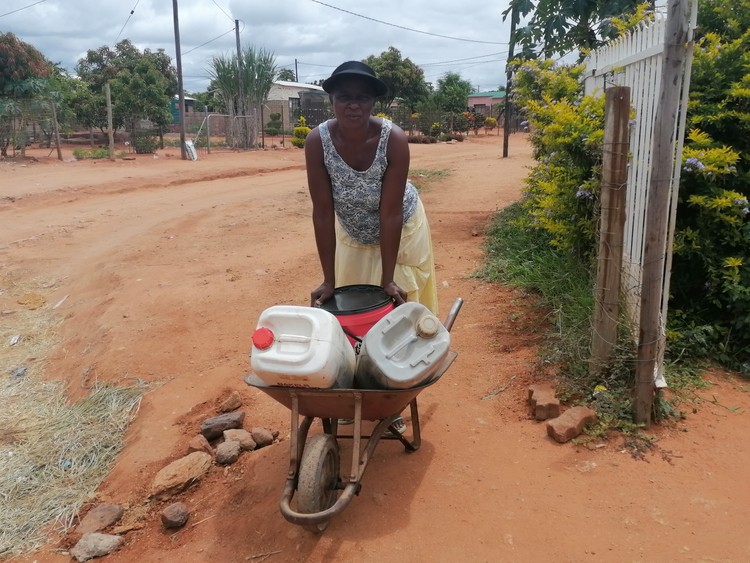A year after protests and promises, the water supply in Musina is still dodgy
Authorities say it’s because boreholes are vandalised
In the three years she has lived in Matswale Extension 14 in Musina, the water supply has never been consistent, says Makie Nevhulaudzi. Photos: Bernard Chiguvare
- Musina was the scene of new water protests last week, with protesters complaining that promises had not been kept.
- At meetings last year after week-long protests, municipal and government representatives promised a plan.
- But the water supply is still erratic, say residents.
- Municipal and national authorities blame the problems on vandalism of boreholes.
Water protests have erupted again in Musina, Limpopo with protesters complaining that in spite of promises made by the municipality, the district municipality, and the deputy minister, their water supply is still erratic.
Earlier this month, protesters briefly closed the N1 with burning tyres. They were dispersed by police.
Last year a week-long protest over water led to destruction of municipal property and looting of some shops owned by immigrants. The protesters said Musina Municipality, Vhembe District Municipality (which is responsible for water provision) and the then Deputy Minister of Water and Sanitation Dikeledi Magadzi have failed them.
On 8 March 2022, ten community members forced their way into a meeting between Magadzi, the Musina municipality and the district municipality. Matodzi Ralushai, Vhembe municipality spokesperson, said then that the meeting had resolved that Vhembe municipality “develop” an immediate, short and long-term water plan”. Lucy Kobe, Limpopo Department of Water and Sanitation spokesperson, said the provincial water and sanitation department was finalising plans to fix Musina’s water challenges. She also promised a follow-up visit by the deputy minister.
But a year later, some parts of Musina are still battling water outages. “Most Musina townships have been without water for three weeks,” a resident who did not want to be named told GroundUp after the protest last week. “Some residents have to buy water, others have to fetch from friends and relatives. We rarely see any water tankers delivering water in Musina. What is most surprising is that our water bills are very high, and we wonder whether the bills reflect the actual amount of water used per month by residents.”
At Matswale Extension 14, Simon Semon was one of several residents who had put containers outside to collect water in the hope that it might rain. He said he could not remember for how long families in the area had been battling poor water supply.
“I’m very lucky today. There is some water from the taps but the pressure is very low. Any time it can stop. I usually leave these containers outside in case it rains,” said Semon.
He said the district municipality had failed to plan for the growth of the town.
A few metres from Semon’s house lives Makie Nevhulaudzi who said her house was among those which rarely got water. “Every day I have to make about three trips to fetch water from my relatives,” said Nevhulaudzi. She has been living there for three years and has never had a reliable water supply, she said.
Simon Semon had put out containers in the hope of catching rainwater.
Ralushai told GroundUp that upgrades to the main line supplying water to Musina would provide a solution, but Vhembe district municipality was still busy with the technical report on this. Meanwhile, he said, water supply had been affected by vandalism of boreholes.
Wisane Mavasa, spokesperson for the Department of Water and Sanitation, also referred to the vandalism of boreholes.
Asked why there was little progress after a year, Mavasa said a technical team made up of the department and Vhembe municipality had been formed to “develop and implement an action plan” and to report to a political steering committee led by the Minister.
“The action plan … included short, medium and long term. Most of the long-term activities are still under implementation while some of the interventions require funding.”
However, there was significant progress on short term intervention, he said, including fixing boreholes and drilling new boreholes. The town had 52 boreholes, of which 29 were operational. But recently vandalism and theft of equipment had affected 10 of the 29. Six had since been repaired, four still had to be repaired and pumping capacity had been affected by loadshedding, said Mavasa.
Support independent journalism
Donate using Payfast

Don't miss out on the latest news
We respect your privacy, and promise we won't spam you.
© 2023 GroundUp. This article is licensed under a Creative Commons Attribution-NoDerivatives 4.0 International License.
You may republish this article, so long as you credit the authors and GroundUp, and do not change the text. Please include a link back to the original article.
We put an invisible pixel in the article so that we can count traffic to republishers. All analytics tools are solely on our servers. We do not give our logs to any third party. Logs are deleted after two weeks. We do not use any IP address identifying information except to count regional traffic. We are solely interested in counting hits, not tracking users. If you republish, please do not delete the invisible pixel.


